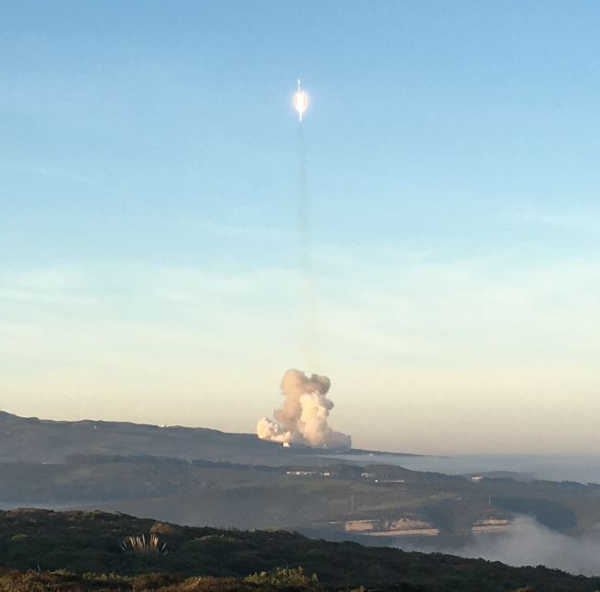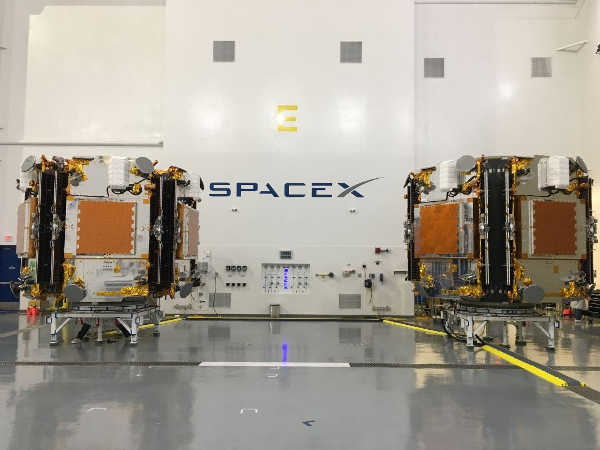
VANDENBERG AIR FORCE BASE, Calif. – As a rising sun held back an encroaching fog slithering from both the nearby coastline and the inland farmland on Friday, fueling vapor could be seen escaping from the SpaceX Falcon 9 rocket perched at the launch tower.
The rocket configuration, or “stack,” launched from Vandenberg Air Force Base where several SpaceX launches have taken place in recent years.
This particular payload, consisting of 10 Iridium NEXT satellites, were secured at the top of the 230-foot-tall rocket, protected inside an eggshell-shaped nose cone known as a fairing.
This fairing protects the payload during ascent as the rocket screams through the atmosphere and then is discarded once the rocket moves beyond Earth’s protective layer, about three minutes and 28 seconds after liftoff.
The Iridium-5 launch is the fifth cluster of satellites out of 10 launches that will strive to form an upgraded web of communication technology around the globe.
SpaceX will be responsible for eight payloads with each launch delivering on average nine satellites for a total of 75 in all. This web will assist people as they utilize the Internet of Things, or IoT, accessible by an enormous array of various technological components.
The instantaneous launch window Friday was at 7:13 a.m. and as planned the rocket catapulted off the launchpad at T-minus zero.
SpaceX continues to demonstrate the reliability of their reusable hardware as this rocket booster, the first stage, flew previously on another mission and was prepared for this flight.
In fact, Iridium points out this Falcon 9 rocket first stage previously carried the third set of 10 Iridium NEXT satellites to orbit back in October of 2017.
Previously flown hardware is often described by SpaceX as “flight-proven.” Veteran rocket boosters from SpaceX are easily spotted from the visual scarring which can be seen on the vehicle as dark marks reflecting the intense heat the booster experiences as it descends back through the atmosphere.
The Iridium-5 mission suffered a temporary setback during launch preparation when a problem with a harness on a satellite provided concerning data.
“We don’t want to launch a brick,” Iridium CEO Matt Desch explained, referring to an unresponsive satellite.
This problem was detected only hours prior to launch and it would be determined that an external testing harness was to blame. Once the problem was identified and corrected, all activity for launch proceeded as normal.
After the first and second stage separation of the Falcon 9 rocket occurs, the second stage initiates thrust from its vacuum Merlin engine and then shuts down for 43 minutes during what is commonly referred to as a coast phase.
Upon restart and a short burn, the second stage has then ensured the satellite payload has achieved the desired trajectory. About 57 minutes into the flight, the 10 satellites began a timed release sequence distributing each satellite not unlike a string of pearls across the sky.
Once each satellite is powered and makes contact with ground crews, they will eventually propel themselves into their desired altitudes and orbits.
When the successful launch and deployment of Iridium’s NEXT payload occurred, Desch provided these remarks. "The new satellites and services we're launching and continued strong subscriber growth are cementing our position as an industry leader and critical global communications platform and underscore the significant transformation we've undergone as a company over the last 10 years. This truly is a testament to the trust our partners and customers have in our network, which is only going to continue growing as the deployment of the Iridium NEXT constellation nears completion."
The partnership between SpaceX and Iridium has proven to be a successful endeavor as SpaceX provides the launch services Iridium needs to advance their technological edge over competitors. There are still a few more planned launches this year with the manifest indicating launches taking place in May, June and August, but those predicted dates can easily change.
Lake County resident Jerome Strach is a Lake County News correspondent and photographer.


 How to resolve AdBlock issue?
How to resolve AdBlock issue? 



